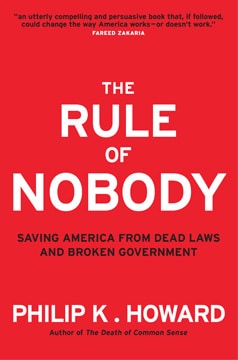Book Summary: The Rule of Nobody
 The Rule of Nobody [homepage | public library]
The Rule of Nobody [homepage | public library]
By: Philip K. Howard
Summarized by Azish Filabi
Overview
In The Rule of Nobody, Philip Howard describes how bureaucracy is stifling U.S. institutions as well as the spirit of autonomy and free will among Americans. We live within a system whereby layers upon layers of often incomprehensible and inconsistent regulations, mandatory disclosures and requirements create a society that is “governed by dead laws” — meaning that since many of today’s laws are so outdated, they have been rendered irrelevant because layers of new (and sometimes inconsistent) laws have been enacted after them, or they have become otherwise destructive to the social good because they hamper progress.
The book is packed with examples of inept laws replacing common sense human judgment. In many cases, government agencies are comprised of well-meaning individuals who can’t apply their common sense and best judgment to resolve the problems they are hired to manage.
His recommendations for restoring human control of democracy and bringing about good government involves a series of reforms (summarized below) towards principles-based regulation, including appointing independent commissions to review and propose amendments to existing laws, to mandatory sunset provisions of all laws with budgetary impact, thus compelling Congress to consider the present needs of constituents when allocating expenditures.
In Howard’s future, people, not laws, would control the government and they would be empowered to use common sense towards the common good. To achieve progress in addressing our major societal challenges and restore human flourishing in our main activities, we need to “put humans back in the driver’s seat…The goal is to liberate people to try to do what’s right and sensible, accountable to those around them.” The purpose of law is to set the boundaries and broad principles so that the government, led by humans, with proper checks and balances in place, is empowered to efficiently regulate societal and business activities.
Summary
Howard describes that the problem with modern U.S. government and bureaucracy is that in many cases, nobody has authority to make a decision on matters of importance. In practice, agencies are hamstrung by laws and lack flexibility to adequately weigh the pros and cons of public choices inherent in administering public affairs.
For example, when Medicare was enacted in 1966, the architects of the program learned within the first year that the Act incentivizes doctors to maximize their revenue, rather than maximizing patient care. Doctors can game the fee-for-service model by conducting additional and unnecessary tests and procedures, at the expense of the government and without financial contribution from the patient. Almost 50 years later, government reform of the law remains unlikely because of continued political impasse, and the bureaucrats administering the law are unable to make common sense adjustments to reestablish focus on patient care.
The root problem for this lack of authority, Howard proposes, is top-down government that governs through detailed laws and rules, thus preventing humans from exercising the common sense judgment necessary for governance.
One example that Howard provides explaining how bureaucratic delay has a substantial impact on necessary infrastructure improvements is the environmental review process. The process takes on average 8 years, thus substantially slowing the pace of progress. In a recent case to upgrade the Bayonne Bridge, which connects the NY Harbor to the Port of Newark and needs to be modernized to accommodate the size of larger shipping vessels that travel on the river beneath it, the project was delayed 4 years just for the environmental review process; this was years after the engineers had designed, developed and received technical approval for the project. The environmental review delays projects, Howard surmises, because interests groups use it as a tactic to obstruct or even prevent projects they oppose. The main goal of the process, which is review of the potential costs on the environment against the benefits to society, is not well served. In the case of the Bayonne Bridge, even the President’s intervention in support of the project could not move it forward, despite the fact that the EPA works for the President. Over three years after the environmental review process began, the Army Corps of Engineers finally gave a finding of “no substantial impact” and contracts were awarded in 2013 to finally begin construction.
For Howard, the burden imposed by our current legal and governance systems hinders two main goals: human flourishing and societal progress. Human flourishing is based on a cornerstone of personal responsibility and sufficient scope to make decisions relating to managing ones routine affairs. Modern government is missing this element of personal freedom – rather than establishing the rules for progress, government hampers citizens and employees with forms, unnecessary legal disclosures, and burdensome requirements “to do stupid things just because a rule requires it.” Howard proposes reforming our system of government to become rooted in human responsibility.
His reform proposals are geared towards restoring human control of democracy. I summarize his key proposals below:
- Regulators should focus on results, not punishments: Howard advocates for principles-based regulation whereby the regulator’s role is to oversee the results of the law, rather than a primary focus on punishing violations of law. He references the “new governance” movement described by Professors Grainne de Burca and Joanne Scott as regulation that is “less rigid, less prescriptive, less committed to uniform outcomes, and less hierarchical in nature.” Legal enforcement and punishment do have a major role in the system, but only as a final escalation after the agencies, in the spirit of mutual trust with industry, observes that the target company is lagging behind its more responsible peers.
One example that has worked in this regard is the nursing home regulations in Australia, passed in 1988. The government replaced its detailed rules (which specified, for example, a floor area of 80 feet per resident), with broad principles, such as creating a homelike environment for residents and treating them with privacy and dignity. Enforcement was also reformed, the new approach relying less on metrics and compliance and more on perspectives of overall quality of the environment (gathered through conversations with residents, families, advocates and other stakeholders). Researchers John and Valerie Braithwaite studied the results of this shift towards principles-based regulation and were surprised to find that the changes prompted a transformation towards measurable improvements in quality of care.
- Congress should appoint independent commissions to propose simplified codes in each area: Given the fundamental importance of the legal infrastructure, Howard proposes that all U.S. laws be re-codified to update and rationalize the existing rules and address overlapping and inconsistent regulations. This could be achieved by Congress appointing commissions who then make proposals for further debate and approval. Recognizing that this is the equivalent of “sending a man to the moon,” he points to the success of the Uniform Commercial Code (UCC) which re-codified existing commercial law after WWII and is widely regarded as effectively providing clear rules for the major areas of commerce.
- All laws with budgetary impact should sunset periodically: The Texas Sunset Advisory Commission is an independent commission tasked with periodic review of state agencies to determine which ones are no longer necessary for as circumstances change, and recommend that it be closed. Howard views this as a model for the federal government, which he believes should have a constitutionally mandated sunset period for all laws with budgetary impact, thus forcing Congress to reform obsolete laws.
- The President must have effective executive powers restored: Howard provides numerous examples of how the President’s ability to run the government has been hampered since the mid-1900s. The balance of powers is currently off-kilter – Congress writes hyper detailed laws in order to tell the President how to implement their mandates. To restore the checks and balances originally conceived by the Constitution, Howard proposes a Constitutional Amendment that would give the President authority to actively manage the executive branch via:
- executive orders to reorganize agencies;
- line item vetoes in proposed budgets, and
- other methods to implement the goals and principles of statutes by means other than those set forth in the regulations.
- Judges must act as gatekeepers to dismiss invalid claims: Plaintiffs increasingly use the courts in modern times to attempt to second-guess, via the judicial system, public policy choices that have been previously legislated.
Howard suggests that lawsuits should mainly be used to enforce a private right (e.g., against the government’s abuse of power) and that the courts should act as gatekeepers over this principle, thus respecting the prerogatives of politically accountable officials as expressed in the laws that they pass. Judges should distinguish between claims that attempt to use the judicial process to in effect re-legislate decisions that have been made by elected bodies, and those that legitimately claim government abuse.
- America needs a “Council of Citizens” to oversee government: A Constitutional Amendment should create a Council of Citizens whose responsibility would be to report on whether government is taking heed of the common good.
Howard describes this 9-member Council, as the “locus of moral authority,” providing citizens a voice in government and breaking the monopoly on public discourse that the government currently maintains. The Council and its staff would be funded by Congress and their only mandatory duty is to nominate the law reform commissions described above, and at their discretion they would evaluate and report on whether the government is responsive to the needs of the citizenry.
Application to designing ethical systems
The Rule of Nobody does not directly address business ethics or the behavior of companies and its employees, but the root problem that Howard describes relating to government bureaucracy —that excessive law is hampering the judgment necessary for effective decision-making— is closely parallel to the corporate governance challenges faced by companies. Executives whose goal is to operate long-lasting ethical companies must consider the following: how do you establish a set of rules, policies and procedures that require and hold employees accountable to compliance with the law and the company’s values, without hampering their ability to flourish, innovate and grow?
In the past 20 years, in response to the Federal Sentencing Guidelines, many organizations have established robust compliance programs in order to monitor employee behavior and ensure adherence to government regulations. Ethics violations and government sanctions, however, have not decreased as a result of these increased compliance efforts, as evidenced by scandals at Enron, World Com and more recently the VW emissions scam, the rigging of LIBOR by banks, and Wells Fargo’s fraudulent opening of multiple accounts for customers. Howard proposes that detailed law and rules can actually prevent humans from exercising judgment to make decisions for to the common good. As a parallel consideration inside companies, could excessive compliance procedures have an adverse impact on the behavior of their employees, who seek only to check-the-box on the required procedures without adhering to the broader principles of ethics?
In addition to the parallel governance challenges, many government regulations are designed to directly impact the actions and outcomes of companies. As the depth and breadth of regulations multiply, companies must develop internal systems and procedures to comply with the detailed rules. It is difficult to see how companies could avoid command and control compliance if government agencies, as Howard proposes, are themselves hamstrung when making decisions about which rules are effective mechanisms to control business actions. The result is a regulatory regime that is too rules oriented, pushing companies to comply with the letter of the law while ignoring its spirit.
Designing ethical systems requires analysis of the interplay of personal, organizational and regulatory systems. Ethical failure at any level can bring scandal, but achieving good ethics at all levels yields enormous benefits in trust, efficiency and happiness. Bringing an ethical systems lens means simultaneously considering these three levels of analysis. The Rule of Nobody adds a necessary perspective about the role of law and regulation in impacting human behavior and stifling human agency. If the regulatory system at the highest level can align with organizations to reward the development of ethical cultures – and if those cultures encourage ethical behavior by employees – then we could have alignment on these systems and improved prospects for ethical outcomes.
More from Philip Howard:
The land of the free has become a legal minefield, says Philip K. Howard — especially for teachers and doctors, whose work has been paralyzed by fear of suits. What’s the answer? A lawyer himself, Howard has four propositions for simplifying US law in this engaging TED talk.
| See additional book reviews | Explore our research topics |





